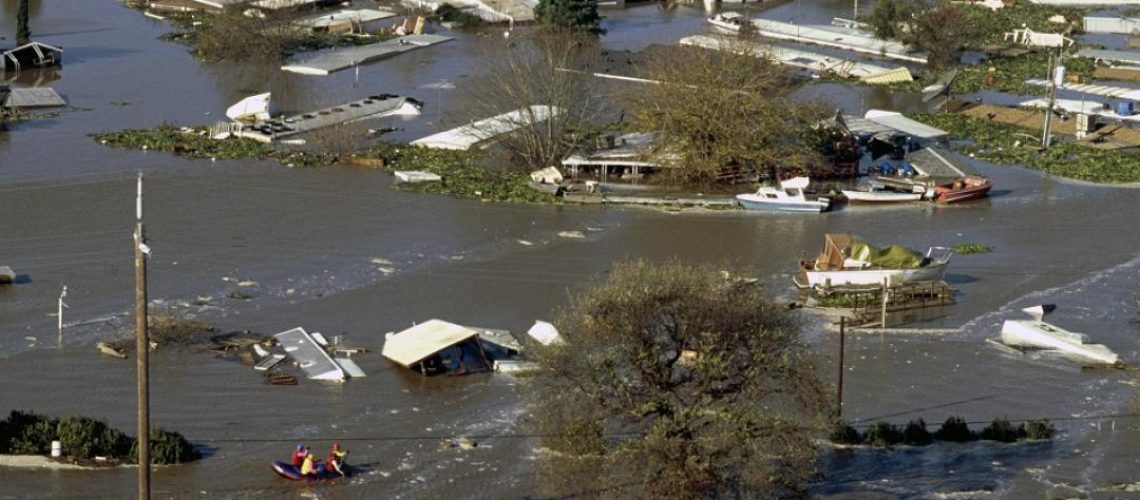My Cold Hometown is Baking
By Jim Paymar
I was born and raised in the coldest city in the lower 48 States of America, Duluth, Minnesota. It rests on a glacially formed hillside on the western tip of Lake Superior, the largest freshwater lake on planet earth. Lake Superior, bounded by Minnesota, Ontario, Michigan, and Wisconsin, has a shoreline of 2,730 miles holding three quadrillion gallons of water–enough to flood all of North and South America to a depth of one foot. The average temperature of the massive lake is a frigid 43°F. People turn blue swimming in Lake Superior like I did this past summer.

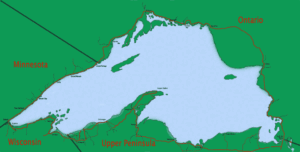
Duluth has often been called “the air-conditioned city” and people from around the country have traveled to the Great Lakes port city for decades to escape the heat of the Great Plains, the Southwest, and the Southeast.
I recall as a kid, temperatures dropping to -35°F for days at a time in January and February and the windchill exceeding -50°F. I delivered papers in that weather. We accepted it as the Northland way of life, skating, hockey, skiing, and snowshoeing. Bob Dylan was born in Duluth and raised in the Northland. He survived the arctic conditions and I think he did pretty well for himself.
But like the rest of planet earth, my hometown is heating up. On Sunday of the Labor Day weekend 2023, the temperature reached a record shattering 97°F. The previous high temperature in September was 89°F. That was a scorcher for Duluth, but eight degrees hotter, that is incapacitating for Northlanders. They wilt in the heat.
The tipping point
Scientists have warned about a global warming tipping point that would occur around the year 2050. That’s when a temperature threshold is passed, leading to unstoppable changes in our climate system. They’ve stated once worldwide temperatures rise 1.5°C above pre-industrial levels, the planet would experience extreme flooding, drought, and wildfires. Food shortages and human mortality would be a reality.
Well, it appears the scientist’s earlier predictions were off by about 25 years. July of 2023 was 1.5°C (2.7°F) warmer than pre-industrial averages in some regions. Temperatures in Death Valley sizzled at 128°F. Baghdad, Iraq baked at 125°F.
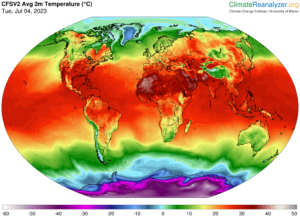
The heat dome in the southwest trapped people in their homes for weeks on end. Phoenix, Arizona had the hottest month on record for any US city. The average temperature was 102.8°F. For 31 consecutive days, temperatures were above 110°F. The irrefutable bottom line–2023 was the hottest year since recordkeeping began in 1880. We’ll never know for certain how many people died from heat exposure.
The wildfire outbreak
The drying out of the planet and the intensive heat caused treacherous fires that ravaged broad stretches of Canada. America’s neighbor to the north has had 6,118 wildfires so far in 2023, the worst wildfire season on record for Canada. The fires burned over 27.1 million acres of forest. At least four wildland firefighters died on duty in Canada, several others died as well, and 155,856 people were evacuated from their homes. The impact on human lungs might not be known for a generation. An inconceivable number of foxes, rabbits, deer, frogs, mice, coyotes, and other animals who were smoked out of their woodland homes were burned alive.
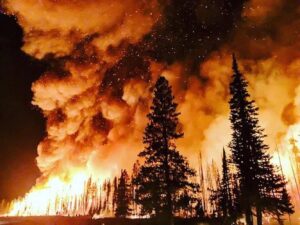
So far this year, Canada’s forest fires have released 290 million tons of carbon, doubling the previous annual record, according to the EU’s Copernicus Atmospheric Monitoring Service. These emissions already account for over 25% of the global total wildfire emissions for the entire year. There are still hundreds of uncontrolled fires burning in Canada today. The Canadian fires impacted much of North America, turning skies orange from the smoke. This is a picture of Manhattan when the smoke wafted down from Canada. What impacts one nation today can impact numerous other nations as winds shift.
The Hawaiian Island of Maui also suffered a horrible tragedy this year. Wildfires totally destroyed the capital city of historic Lahaina, and 115 people died in the hellish blaze.
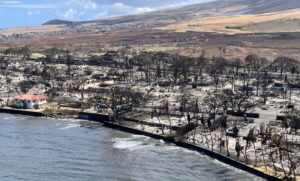
Greece couldn’t control 350 raging forest fires, which killed 28 people, destroyed homes, forced 12,000 people to evacuate, and burned 470,000 acres of forest land. Fires burned out of control on the Greek Island of Rhodes scorching 15% of the island’s surface area and burning 50,000 olive trees. After the fires, torrential rains ravaged the country, and at least 15 more people died. Spain, Italy, and the Island of Tenerife also suffered through ravaging fires that destroyed thousands of acres of timber.
Impacts on other species
The extreme heat we are experiencing also stresses plants, including common crops. This causes them to go dormant or to seed, stunting growth and disrupting pollen and, therefore, fruit development. In a study published in Nature’s Climate and Atmospheric Science Journal this June, researchers found that extreme heat is now more likely to affect wheat yields in the US and China, a major wheat exporter.
One study estimates that each 1.8°F increase in global average temperature could see reductions in global yields of wheat by 6%, rice by 3.2%, and maize by 3.2%. American farmers are draining aquifers to save their crops, and in the past 40 years more water has been pumped out than mother nature could replenish.
Ice sheets in Antarctica are fracturing. The docile and beautiful emperor penguins find there isn’t enough sea ice to support their little babies. Sea ice is melting underneath their breeding platforms before chicks can develop the feathers they need to swim and stay warm, leaving them to drown in the frigid waters.

This year, the world’s oceans, more than 70% of the Earth’s surface, were the hottest ever recorded at nearly 21°C (69.8°F) and set high temperature marks for three consecutive months. Stepping into the waters offshore from Miami was like entering a hot tub. Coral and other creatures of the sea are perishing. As coral bleach and die, the protective coastal barriers they create weaken, allowing storms to ravage coastlines. Major flooding inundated the American Northeast and California. China, India, and Japan also experienced massive floods. The cost of the destruction, globally, is already in the hundreds of billions of dollars. Flooding alone has cost US taxpayers more than $850 billion since 2000.
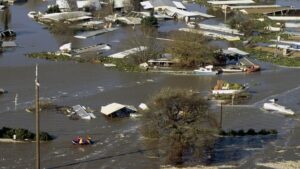
We are reaching the tipping point where we will be unable to stop global warming, which is contributing to an extinction crisis for thousands of species. More than 42,100 species are threatened with extinction according to the International Union for Conservation of Nature’s “Red List.” Biodiversity loss threatens the ability of our planet’s life to survive, and that includes you and me, mankind, at the top of the food chain.
What do we do now?
So where do we stand? Right now, today, there is already so much carbon in the atmosphere that it will take decades for it to dissipate. Between 65% and 80% of CO2 released into the air dissolves into the ocean, but that can take from 20-200 years. On the bright side, there are scientists and technology experts, as well as well-meaning citizens around the world trying to grapple with the terrifying impact of global warming. If there is true collective action by the world community, we may be able to save the planet for our children and grandchildren who will experience a dystopian world if we don’t take dramatic action.
Since the landmark Paris Climate Agreement passed in 2015, the world’s nations have not acted to cut pollution and avert catastrophic levels of warming. That is according to a United Nations report issued in September of 2023.
So, what can each of us do and how fast can we act? We all have a role to play. For example, in our own households, we each have a personal carbon footprint. We use electricity, we drive, we have smartphones and TV’s that all need power.
What can we do?
If each person took action, a few minor steps each day, we could make a tremendous impact in slowing global warming. Imagine if each human on the planet—there are 8 billion of us here today, rising to 10 billion by 2050—contributed to climate action. We might be able to reverse a potential global catastrophe. See if you could take one or two of the steps listed below.
- Reduce Energy Consumption:
- Energy-efficient appliances: Replace old appliances with energy-efficient ones, such as LED light bulbs and Energy Star-rated appliances.
- Home insulation: Improve insulation and seal gaps in your home to reduce heating and cooling needs.
- Thermostat management: Use a programmable thermostat and set it to save energy when you’re away or asleep.
- Unplug devices: Disconnect electronics and chargers when not in use to prevent “phantom” energy consumption.
- Support Renewable Energy:
- Solar panels: If feasible, install solar panels on your home to generate clean energy.
- Wind energy: Consider using wind turbines if your location permits.
- Advocate for and support policies and initiatives that promote renewable energy development.
- Consider purchasing renewable energy certificates (RECs) to support clean energy production.
- Reduce Water Usage:
- Fix leaks promptly.
- Install water-saving fixtures like low-flow toilets and showerheads.
- Collect rainwater for outdoor use.
- Install low-flow faucets and showerheads.
- Transportation:
- Public transport: Use public transportation, carpool, or bike whenever possible to reduce personal vehicle emissions.
- Electric or hybrid vehicles: Consider switching to an electric or hybrid vehicle when purchasing a new one.
- Walk or bike: Use non-motorized transportation for short trips.
- Make one trip: Rather than several trips to the store or mall, plan so you make just one.
- Don’t leave your car running needlessly when picking your kids up or stopping at a friend’s home.
- Reduce, Reuse, Recycle:
- Minimize waste by practicing the three Rs: Reduce, Reuse, and Recycle.
- Compost organic waste to reduce landfill contributions.
- Eat Sustainably:
- Reduce meat consumption: Consuming less meat, particularly beef, and dairy can significantly lower your carbon footprint. Cows emit a tremendous about of methane and take up huge spaces of land that could produce other food.
- Choose local and seasonal foods: Support local agriculture and reduce the carbon emissions associated with food transportation.
- Reduce food waste: Plan meals, store food properly, and compost food scraps.
- Reduce Air Travel:
- Minimize air travel, when possible, especially for short trips where alternatives like trains or buses are viable.
- Conscious Consumerism:
- Make informed choices when buying products, opting for items with minimal packaging and sustainable materials.
- Support companies that prioritize environmental sustainability.
- Educate Yourself and Advocate:
- Stay informed about climate change and its impacts.
- Advocate for climate-friendly policies and practices in your community and beyond.
- Support organizations working to combat climate change.
- Carbon Offsetting:
- Consider carbon offset programs to compensate for unavoidable emissions by investing in projects that reduce or capture carbon.
- Plant Trees and Greenery:
- Participate in local tree-planting initiatives or create a garden with native plants to sequester carbon and support biodiversity.
- Reduce Single-Use Plastics:
- Use reusable bags, containers, and bottles to minimize single-use plastic consumption.
- Support Sustainable Practices at Work:
- Encourage your workplace to adopt energy-efficient and sustainable practices.
Individual actions, when collectively adopted, can make a significant impact on reducing carbon emissions and mitigating climate change. Leading by example and encouraging others to follow suit is essential in creating a more sustainable future.
Perhaps one of the most important things we can do is to make sure when we go to the polls, we vote for candidates who support a clean, green agenda. If each branch of government—our local community, our state, our nation, and nations around the world—elects environmentally proactive representatives, they could create powerful laws needed to rein in polluting industries and incentivize other industries that create alternative clean energy.
There are also myriad inventions and innovative technologies coming online from private enterprise and academic institutions that could help us reduce carbon emissions. We need collective, international government action to help these technologies become a reality quickly enough to reduce carbon emissions.
- Direct Air Capture (DAC):
- DAC technology involves the capture of CO2 directly from the atmosphere using chemical processes or specialized materials. This captured CO2 can then be stored underground or utilized in various applications.
- Enhanced Weathering:
- Enhanced weathering involves speeding up the natural process of rock weathering, which absorbs CO2. Crushed rocks are spread on land or at sea, where they react with CO2 to form stable carbonates.
- Bioenergy with Carbon Capture and Storage (BECCS):
- BECCS combines bioenergy (e.g., biomass power plants) with carbon capture and storage (CCS) to remove CO2 from the atmosphere. It involves growing biomass, burning it for energy, and then capturing and storing the CO2 emissions.
- Ocean-Based Carbon Removal:
- Various approaches are being explored to enhance the ocean’s capacity to absorb and store CO2. This includes ocean afforestation (planting kelp forests and seagrasses) and ocean alkalinity enhancement.
- Mineralization and Carbonation:
- Some technologies focus on converting CO2 into solid minerals through a process called carbon mineralization or carbonation. This can be done through mineral storage or utilization in construction materials.
- Artificial Photosynthesis:
- Artificial photosynthesis seeks to mimic the process by which plants convert CO2 and sunlight into energy. Advanced materials and catalysts are being developed to improve the efficiency of this process.
- Carbon Farming and Soil Carbon Sequestration:
- Innovative farming practices, such as no-till farming, cover cropping, and agroforestry, can enhance soil carbon sequestration.
- Hydrogen-Based Energy Systems:
- The production of “green” hydrogen using renewable energy sources and its use as a clean energy carrier can help reduce CO2 emissions, particularly in industrial sectors.
- Advanced Carbon Capture and Utilization (CCU):
- CCU technologies capture CO2 emissions and convert them into valuable products, such as synthetic fuels, chemicals, and building materials.
- Biotechnology and Synthetic Biology:
- Advances in biotechnology and synthetic biology are being harnessed to develop microorganisms that can capture or utilize CO2, as well as produce biofuels and bioplastics.
- Nuclear Fusion:
- While not directly a carbon removal technology, nuclear fusion has the potential to provide abundant, carbon-free energy, which can help reduce emissions from fossil fuel power generation.
- Climate-Responsive Materials:
- Innovative materials are being developed that can capture and store CO2 from the air, such as absorbent polymers and porous solids.
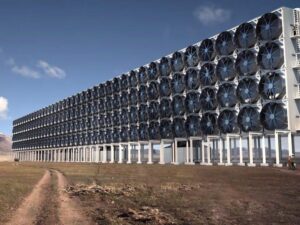
Giant machines could vacuum carbon dioxide from the air

Canada switches on world’s first carbon capture power plant

MIT engineers develop a new way to remove carbon dioxide from air
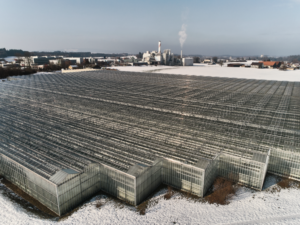
Small Swiss company believes it can reduce carbon through direct air capture
What will it take for nations to stop the impending climate disaster we are living through? Perhaps cataclysmic events will force powerful nations to take drastic action to stop emitting carbon before we destroy the world as we know it today. But we can’t wait for that.
The major industrialized nations of the world are competing for economic and political dominance. Each of those nations, in their quest for superiority, are also the major polluters of the world. As they grow their economies and militaries, they are destroying the environment. The nations below have a moral imperative, an obligation, to reduce their carbon footprint.
- China, with 10,065 million tons of CO2.
- United States, with 5,416 million tons of CO2.
- India, with 2,654 million tons of CO2.
- Russia, with 1,711 million tons of CO2.
- Japan, 1,162 million tons of CO2.
- Germany, 759 million tons of CO2.
- Iran, 720 million tons of CO2.
The major polluters of the world are selfishly thinking about their own futures while allowing the world to incinerate. But what will be left behind? What kind of dystopian world are we creating? If we have children and grandchildren, will they be able to survive and thrive? What will happen if our seas rise to the point that people are forced from coastal areas inland? Who will control the land? Will the wealthy push out the poor?
What if temperatures rise to point where people cannot survive? Humans can endure about 10 minutes in 140’F heat before hyperthermia, a lethal form of heat stroke, sets in. We’re coming awfully close to that temperature today. What happens when the glaciers melt and there is not enough water flowing into rivers to sustain life downriver? Nations that are damming up rivers to sustain their own populations are making enemies of their neighbors. Wars are already being fought over water supplies and will likely only get worse.
People who are thinking logically and looking at the scientific data know we’re at a tipping point, and if we desire a verdant planet earth for the future, we are going to have to take forceful action now. Kicking the can down the road will only lead to chaos and possible warfare over resources, land, water, food, and energy.
Let’s make every day count! Start doing one thing, two things, three things daily in your own life. Reduce meat consumption. Turn off the lights. Drive less. Turn down the AC and heat. Vote for green energy political candidates. Buy stock in companies that are dedicated to a zero-carbon footprint. Don’t support companies that are known polluters. Get active politically in environmental causes you believe in. Talk to your neighbors and friends and encourage them to take action.
START SOMEWHERE AND DON’T STOP!

